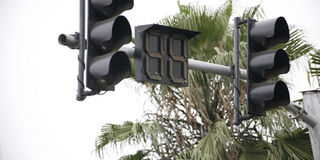Why city’s new traffic lights are out of sync

Traffic lights on Bunyala round-about that were not functional, on December 20, 2013. A disconnect between City Hall and the Traffic Department has stalled the Sh430 million project initiated last year to control city traffic. FILE PHOTO | PHOEBE OKALL | NATION MEDIA GROUP
What you need to know:
- However, a senior City Hall official involved in the project said the traffic police had frustrated efforts to implement the system.
- From the room, they can monitor roads that have heavy traffic to control them in order of priority.
- Traffic jams have become a nightmare and there is fear that the project may have become a white elephant.
A disconnect between City Hall and the Traffic Department has stalled the Sh430 million project initiated last year to control city traffic.
The digital lights with CCTV cameras on some roads in the city centre are not connected to a control room, as they should, so as to ensure traffic flows smoothly.
The sad state of affairs is due to lack of coordination between the Nairobi County government and the Traffic Police department.
“This project is not under the police and our work was only to do the monitoring. I don’t know where it reached since City Hall is yet to communicate with us on the progress,” Police spokesperson Gatiria Mboroki told the Nation.
Ms Mboroki said the Traffic Department was only involved in the initial stages of the project.
City Hall has remained silent on the matter and efforts to get a response from Governor Evans Kidero’s office have been futile since last week.
However, a senior City Hall official involved in the project said the traffic police had frustrated efforts to implement the system.
“It is like the police do not want to stop manning the traffic flow in the city,” the source, who asked not to be identified as he is not the official spokesman for the project, said.
SYNCHRONISED LIGHTS
He said Dr Kidero would soon update the city’s residents on the progress of the project.
Traffic police are required to be synchronising the lights in a control room with screens connected to the cameras installed in the streets.
From the room, they can monitor roads that have heavy traffic to control them in order of priority.
This will stop the traffic police from manning the roads and roundabouts in Nairobi as human intervention will be rendered unnecessary by the electronic control system.
Ms Mboroki denied that the Traffic Department was the stumbling block to the project.
She said City Hall had not even requested for a control room from the police.
The National Transport and Safety Authority (NTSA), which is the other party in the implementation of the project, is required to develop a database where number plates of vehicles flouting traffic rules captured by the cameras should be recorded.
FOLLOW-UP
After the recording, police are supposed to follow-up the culprit and take appropriate action.
As the blame-game continues, city residents keenly await to see how the new system will work.
Traffic jams have become a nightmare and there is fear that the project may have become a white elephant.
Mr Mathew Munyao, the NTSA road safety director, said on Monday that they were developing the database.
“The project cannot operate without the database and we have to give it more time,” he told the Nation in an a telephone interview.
DIGITAL PLATES
And it all may have to do with the delay in the introduction of digital number plates that would help safety officers and the police track down drivers, he explained.
“I am sure the project will eventually be complete and we are organising a meeting with City Hall to discuss the issue.
“There must be a database from where registration numbers of vehicles will be captured and this record can only come from us.”
However, he clarified that the traffic control project belonged to City Hall, its initiator and co-implementer.
The project, which is funded by a Chinese company, is being implemented through a transport integrated management system, although City Hall.





